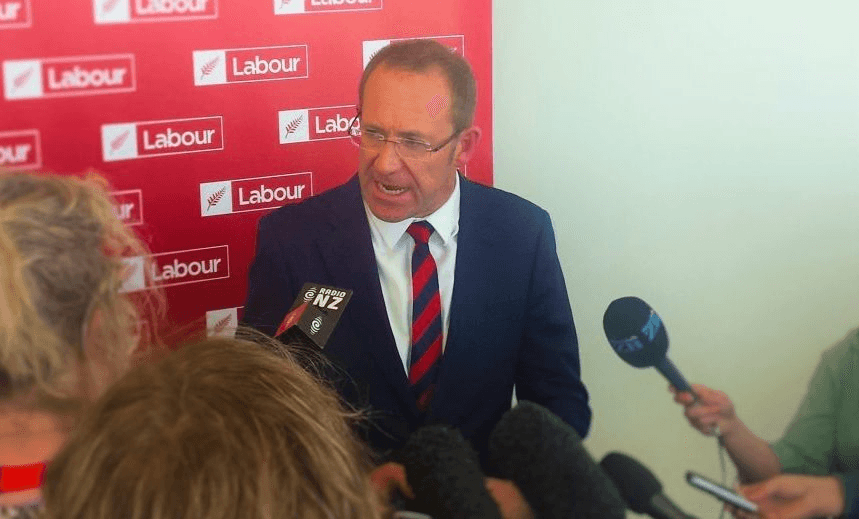The Labour Party conference concluded with a fire-in-belly speech from Andrew Little. Toby Manhire went along to watch.
While one nation in the continent of North America sucks up all the political oxygen on Earth, feeding a giant ball of pulsating fire, there is something reassuring about New Zealand Labour Party delegates gathering together on the Auckland waterfront for their annual conference, complete with raffles and home-knitting and the proverbial hardworking kiwis nattering over cups of tea.
I must have had America on the mind, however, because Donald Trump was the first thing I thought of when Andrew Little, during his leader’s speech this afternoon, talked about a work of art that “made my arms look much bigger than they are”. It wasn’t, of course, a reference to small-handed leaders, but to the framed, hand-woven rug that depicted the Labour leader starkers. Little dropped a few gags about it (“I think the style is called social realism; I’m just thankful it wasn’t cubism”) and so did Jacinda Ardern when she introduced the big speech (when she had gingerly texted him to alert him to its existence, he’d replied, “It certainly adds new meaning to the term member of parliament”), but mercifully there was no sign of any similarly inspired works on the merch stand.
Fabric dicks notwithstanding, the challenge for Labour less than a year from an election was to attract attention but not for the wrong reasons. Since the nightmare of the 2012 conference, when the debates around redesigning the constitution were watched over by media, feeding coup talk which largely derailed the event, the press have had much less access. When I arrived just before the Little speech, members of the media bench were seething about having been forced to perform the “walk of shame”, after being ejected following Annette King’s speech earlier in the day. The prohibitions on press attendance have, I was told, become even stricter than National’s.
The centrepiece policy announcement was “Ready for Work”, a programme to provide temporary employment for young people not in education, training or employment; and while parts of it seemed kind of woolly – the costings, the degree of compulsion, the vague models of similar success that Little cited – in the scheme of things it’s not a huge policy plank: ticking the right symbolic boxes without attempting to any almighty game-changing status.
I thought it was a solid speech. There were no wild rhetorical flourishes, but Little recognises that’s not his metier – just as John Key recognises it isn’t his – and registered a respectable fire-in-belly score, without lapsing into anything that might excite the National Party’s “Angry Andrew” monitoring corps. The declamation that “polls show it’s a neck and neck race between the centre-left and centre-right blocs” is debatable, but it’s not an outrageous thing to say, and the floor wanted to hear it. “You look like a party ready to win an election,” Little told them. I don’t know about that, but they were at least paying attention.
There was the Labour jazz standard emphasis on health and education, but the policy area that got the most emphasis was housing. (Curiously, there is no mention of climate policy in the distributed speech, but when he delivered it Little said climate change was something that should be addressed in an improving economy; perhaps the Greens, who were attending in bloc support mode, had scrawled the line in late.)
On housing, the one thing that was missing – and it surprises me that they don’t bang on about this all the time – was that Labour were alert to the crisis years ago. Something like: “The idea that this is some sudden, unexpected, out-of-the-blue crisis is a nonsense, and that’s why, four years ago, we announced a massive house-building policy, Kiwbuild, at that 2012 conference which otherwise was a bit of a clusterfuck for us.” Or maybe not the last bit.
What matters to the strategists in the short term, of course, is the way the conference and its climax speech play in the headlines and on the 6pm bulletins. On the NZ Herald site, at the time of writing (9.30pm on Sunday; I got distracted), the story takes a good few scrolls to arrive at, and it’s a reasonably straight take that will encourage Labour’s spinners.
On Stuff, this is the only mention of Labour or Little on the front page:
On the Sunday evening television news, the Labour conference sat beneath two major stories from the United States: Donald Trump, naturally, but even more importantly, the historic defeat of the All Blacks by the Irish in Chicago, and all conceivable angles on the result (happy Irish people at pub in New Zealand; happy Irish people at pub in America; happy Irish people at pub in Ireland). Little and Labour were third story off the rank on both One, or TVNZ 1 or whatever it’s called, and TV3 or Newshub, or whatever it’s called.
On 1, the thrust of the story was the policy, and questions over whether or not the costings were overly optimistic, with Steven Joyce, who was reliably tweeting his rebuttal to the policy even before it had emerged from Little’s mouth, shaking his head in disappointed delight.
Over on 3, the coverage was comparatively effusive, especially the sign-off: “With Andrew Little, it seems Labour has finally found a leader who can rally the troops to take on Brand Key.”
The room didn’t feel to me especially as though it was, to borrow a Keyism, on the cusp of something special. But – notwithstanding some cataclysmic defeat in Mt Roskill on December 3 – Labour can be confident, to bastardise a Joyceism, that while they have a long, long route to becoming a serious contender in the 2017 election, they are at least rowing in the same direction.





